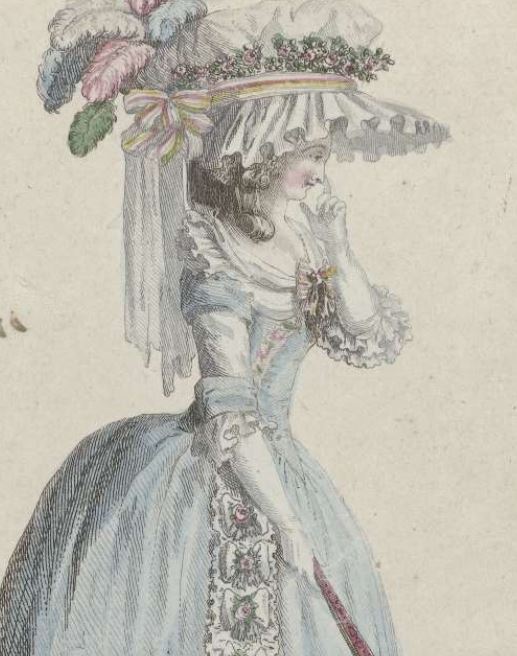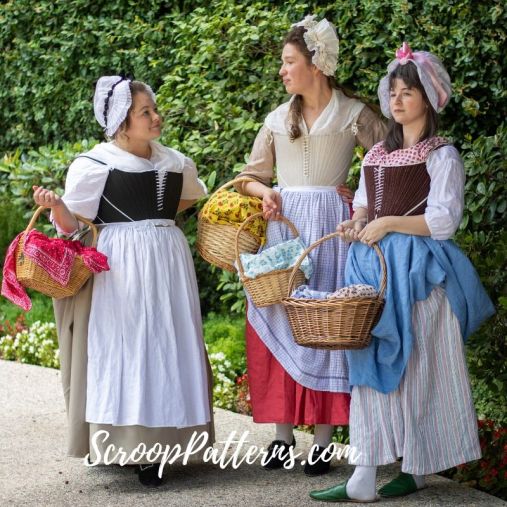We’ve had a lot of questions about the 1780s Augusta Stays, and what makes the 1780s different from the surrounding decades. Here’s a quick post to address a few of them!
Hallmarks of 1780s Stays
A Softer Silhouette: The late 1770s through 1780s really is the beginning of experimental foundation garments that nod toward the loosening silhouettes the early “Regency” or “Federal” era. From what we can gather via images from the time and extant examples is that from around 1775-1789 the straight and primarily fully boned silhouette of the earlier stays styles become more buxom and relaxed. Many examples of “half” or “partially” boned stays from this time period allow the body’s natural shape and contours to influence the stays into a more rounded and slightly more natural silhouette. Whalebone is still the primary source for the boning and the stays are made in a variety of different materials: linens, wools, cottons, blends, and even paper is utilized in some cases.*

Here is a great depiction of the “prow front” curvature of the idealized silhouettes from this period. Having the right type of stays make this possible- OR using extra padding to make up for it in your earlier stays;) Detail from Cabinet des Modes ou les Modes Nouvelles, 15 mai 1786, Pl. I, A.B. Duhamel, after Pugin, 1786, RijksMuseum
Partial Center Front Lacing: This rounded bosom and “natural” curvature is due in part to the use of partial lacing at the center front of the garment. In some extant examples, the lacing at the front doesn’t allow for much adjustment in size, while in others it provides an option to have more of the “prow” shape at the front… or if you want to give your decolletage a little more “oomph” it can help with that.

There’s a wee bit of wiggle room in there for giving that softer front. Stays, Great Britain, 1780-1789, Linen, Victoria and Albert Museum, T.172-1914
Fewer Boning Channels: The popularity of the partial boning pattern (often referred to as “Half Boned”) also makes the “natural” silhouette easier to accomplish. Whalebone, being the same protein of hair, horn and fingernails, bends and moulds when in contact with heat- so… Fewer boning channels + Somewhat Bendy Pliable Whalebone = A more “Natural” figure. Some examples even have cording- which gives a little bit of support but not nearly as much as a channel of boning might. Because less face it: Having less of an armored vest and more of a light bustier help emphasize that soft and gentle curve of the body so sought after.

I love this piece- cording, boning, delicate lines. So gorgeous. Stays, France, 1785-1790, Musee McCord, M969X26
Extreme Angles in Pattern Pieces: If you’re looking carefully, you’ll notice that the front piece of most extant stays from this decade have an extreme angle to attach to the side seams. Having the extreme angle allows for the boning pattern to fan out and makes the bust even more thrusted forward- which can be emphasized as-is or with the aid of padding.

This piece is so awesome to show that crazy angle of the front pieces. Without that angle, it’s very hard to achieve the silhouette without additional padding at the front. Stays, Last quarter of 18th century, Norske Folkemuseum, NF.1914-0210
There’s also an interesting flair in many examples of the side back pieces. One example from PoF5 has a gore, but many of them feature a more extreme flair to the bottom as one piece. What’s great about this feature is that the kidneys and lower back are not crushed by a harsh waistline if you happen to lace too tightly. I’ve found this small detail to make a HUGE difference in how comfortable the 1780s stays shapes are.

The blue lines show what piece and curvature I’m talking about. Rather than that piece having straight lines, the flair enables comfortable wear and an emphasized back curvature as well (helpful for the badonkadonk) Stays, 1780s (made) Red Wool, England, Victoria and Albert Museum, T.192.1929
Straps: Most of the examples from this brief time period have straps of some kind, be it a constructed strap or an adjustable tape. Having the straps on a pair of these stays help bring the sides of the bust up and out, pushing the bust tissue forward, and almost acting the same as a demi-cup or push-up bra. Images and extant stays from the 1750s- early 1770s tend to emphasize a wide and flat front bustline, acting more as a means to lift and separate the bust upward rather than push it outward. The straps are also pretty important for keeping the waistline slightly higher- since the straps are holding up the garment, rather than gravity forcing the stays down to settle at the squishiest part of the body… the waist.

This is a fun example of straps that aren’t necessarily the traditionally constructed straps that many of the other images show. The straps make a HUGE difference though. Corset (Stays) 1780-1790, Scotland, National Gallery of Victoria, Melbourne, CT38-1984
A Slightly Higher Waistline and Deeper Tabs: Another interesting note about stays from this 15 year time period is the location of the waistline: Prior to the 1770s (we’re talking 1700-1760s), the waistlines of stays resided either directly at the waist or -if you’re fancy- just below the natural waist. Many of the examples of late 1770s-1780s stays are slightly shorter in length and are meant to for the waistline to be right at OR ABOVE the waistline the closer to the 1780s and 90s you go.

Here’s a great example of a mid-late 1780s pair of stays as the waistline of popular silhouettes begin to creep up. The tabs are still pretty long though, when they start to be teeny tiny tabs, you know you’ve gotten into the 1790s! Tan Cotton Stays, 1780s, Lot 77, Augusta Auctions
Deeply cut and long tabs also enable a smooth waistline- though the tabs innermost cut should sit around 1/2″-1″ below the waistline to ensure your stays won’t cut off circulation at the smallest part.
Interesting myths surrounding these styles:

She’s thinking, “Why on earth would moderns think that!?” Sketched Image, Source Unknown though attributed to The British Museum, I could not find any information!
Breastfeeding: There has been speculation from many, many people that the partial lacing is used for breast feeding or to have the option of lacing without aid from another person. I am not at all convinced of either of these speculations.

Up and Over, my friends. “A Lady and Children” Mezzotint, 1780, Attributed to Pine, The British Museum, 2010,7081.3005
From my own experience, breast feeding up and over the top edge of the stays is not unattainable (actually quite easy for me) and didn’t require partially undressing. There are also many depictions of mothers breastfeeding their children in this manner. According to other clothing historians, stay makers, and scholars I have spoken with on this subject it’s very hard to definitively say that this style is exclusively for breastfeeding as there is not an excessive amount of milk protein residue left in the stays in the original garments that would lead to that conclusion.
Ease of Lacing: The other “myth” I have encountered is that this partial lacing allows for one to lace themselves into the stays by themselves because the front is open.

There is NO WAY that circumference (blue line) when laced closed at the back would fit over your head and shoulders. No sir. Stays, Last quarter of 18th century, Norske Folkemuseum, NF.1914-0210
This cannot be true. With partial front lacing, note where the front lacing ends- right at the waist and smallest measure of the garment- it is impossible to have the center back laced all the way closed and to pull the garment over your head to be able to lace “by yourself.” Since a few examples don’t have much option for adjustability to begin with I find it hard to conclude that it was used for ease of dressing by oneself .There are a few methods to lacing yourself into a back-laced pair of stays but more on that later…

Ahhhh so comfy. This is my pair of 1780s Augusta Stays made from our pattern based off of all this (and more) research. Photo by Leimomi Oakes of The Dreamstress blog Pattern by Scroop Patterns and Virgil’s Fine Goods available here!
All in all, I really love the shape I have in the pairs of 1780s stays I have made. I’m a huge fan of partial boning because it’s lighter to wear, faster to make, and extremely comfortable. I also just love wearing 1780s fashions because of the extra froof and femininity mixed with the restrained characteristics of the period.

Here we all are in our new 1780s Augusta stays at Costume College 2019! We had so much playing fruit and chocolate sellers. Also, how can you not love the 1780s?!!?! Photo by Leimomi Oakes of The Dreamstress blog
If you want to check out more information regarding this topic, check out my links below!
*In the Patterns of Fashion 5 book, there is information on a lovely pair of stays that used paper as a reinforcement between silk layers.
Additional Information:
Extant 1770s-1780s Stays:
Winterthur 1952.0275, c. 1750-1780
NT 1349940, fustain, c. 1750-1800
A set of stays from the Marjorie Russell Clothing and Textile Museum attributed to the Billinghurst family, linen, c. 1760-1780
MoMu T12/123/O11, silk damask, Netherlands, 1770-1790
Augusta 8.4833.85.177, tan cotton lined with homespun linen, England, c. 1775-1785
BATMC I.27.866, linen and cotton, c. 1775-1799 (Site unsearchable, but pictures available here)
V&A T.909-1913, stays covered in silk damask, lined with linen, reinforced with whalebone, England, 1770-1790
Colonial Williamsburg 1986-45, beige cotton stays, England, c. 1780
Front view and back view, pink jean linen with blue silk, England, c. 1780-1790
Museum of London 49.91/1, brown cotton twill corset with front-tied shoulder straps and center-back lacing, c. 1780-1795
1998-162-50, linen plain weave partially boned stays, United States Provenance, late 18th century
Brown stays, late 18th century, Italian provenance
M969X.26, apricot color partially boned and corded stays, c. 1780-1790
NF.1914-0210, tan partially boned stays, late 18th century
GOS-Nr. AK001867, blue damask front and back lacing stays, c. 1785-1800
OK-13436, yellow back lacing stays, no tabs, c. 1740-1780
T.192-1929, red wool stays, England, c 1780s
T.910-1913, tan silk diaper stays made for doll or sample, England, c. 1770-1780
T.911-1913, buff linen stays without straps, front lacing, England, c. 1780
Period Images of 1770s-1780s Stays:
D,2.3757, Strange Stay Maker trade card, c. 1780-1790s
1874,0711.838, “L’Essai Du Corset” Antoine Francois Dunnel, 1788
1868,0808.4540, “Frontispiece to Anstey’s election ball, 1776
1935,0522.1.108, “The Last Shift” Carington Bowles, 1790-1793
2010,7081.3029, “A Morning Frolic or The Transmutation of the Sexes”, John Collet, 1780
B1977.14.6315, “The Rustic Lover” Francis Wheatley, 1786
RP-P-2009-1157, “Tailleur costumier essayant un cor de la mode” Pierre Thomas la Clerc, 1778
S.1226-2009, “An Actress at her Toilet, or Miss Brazen just Breecht” by Thomas Collet, 1779
1871,1209.602, “Strawberries Scarlet Strawberries” by Francis Wheatley, 1795
Books that include Stays of this style:
Patterns of Fashion 5 – The School of Historical Dress
Costume in Detail 1730-1930 – Nancy Bradfield
Corsets: Historical Patterns & Techniques – Jill Salen
Corsets and Crinolines – Norah Waugh
Underwear: Fashion in Detail – Eleri Lynn
Sewing Patterns available:

I loved this! Thanks for answering all of these questions.